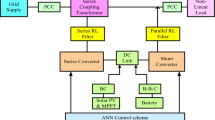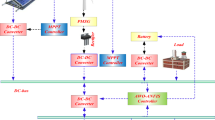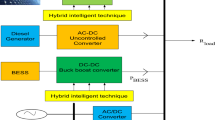Abstract
Energy production with uncertainties in renewable energy sources (RESs) leads to voltage instability at the point of common coupling (PCC), which affects the normal operation of various RESs interconnected with the system. The static synchronous compensator (STATCOM) employed in PCC reduces the voltage fluctuations at PCC with better dynamic performance. The controller used in STATCOM determines the effectiveness of voltage stability within the system. Thus, in this research work, a honey badger-tuned adaptive neuro-fuzzy inference system (ANFIS) controller is proposed for the STATCOM in hybrid RES. A hybrid RES system is designed with a solar photovoltaic (PV), wind-based doubly-fed induction generator (DFIG) and diesel generator. A diesel generator feeds power to the system when RESs fail to meet the load requirements. A STATCOM-based FACTS device is inserted within the system to preserve voltage stability in the PCC. To enhance the static and dynamic performance of the STATCOM functionality, a hybrid controller consisting of ANFIS and the honey badger provides pulses to the STATCOM. The ANFIS has to extract the numerical models from the numerical data, improving the control performance; moreover, the honey badger has to solve the complex search space and its superiority in terms of convergence speed. Thus, the ANFIS and the honey badger are used in this system by combining both advantages to control the STATCOM functionality, thus leading to the error-free output voltage. The proposed hybrid RES with STATCOM has been implemented using MATLAB/Simulink platform. The performance efficacy of a proposed method is compared with proportional integral-based ant colony optimization (PI-ACO), proportional integral derivative-based genetic algorithm (PID-GA), marine predator algorithm PID acceleration (MPA-PIDA) and improved field-oriented control (IFOC). The overall efficiency of a proposed ANFIS-HB is 99.1%, the computing time is 40 min, the settling time is 0.46 s, the maximum voltage is 1.1 V and the percentage of overshoot (POT) is 11%.














Similar content being viewed by others
Data availability
Data sharing does not apply to this article.
Abbreviations
- \(I_{{{\text{PH}}}}\) :
-
Photovoltaic current
- \(I_{{\text{S}}}\) :
-
Saturation current
- \(q\) :
-
Coulomb equivalent of one electron equal to 1.6 1019 C
- \(A\) :
-
Diode ideality factor
- \({\text{k}}\) :
-
Boltzmann’s constant
- \(T\) :
-
Temperature of PV panel
- \(I\) :
-
Load current
- \(V\) :
-
Terminal voltage
- \(R_{{\text{L}}}\) :
-
Load resistance
- \(R_{{\text{S}}}\) :
-
Series equivalent circuit resistance
- \(R_{{{\text{SH}}}}\) :
-
Parallel equivalent circuit resistance
- \(R_{{\text{s}}}\) :
-
Stator resistance
- \(R_{{\text{r}}}\) :
-
Rotor resistance
- \(M_{{{\text{sr}}}}\) :
-
Mutual inductance of stator and rotor winding
- \(\omega\) :
-
Speed
- \(\omega_{{\text{r}}}\) :
-
Rotor mechanical angular speed
- \(\omega_{{\text{s}}}\) :
-
Stator electrical angular speed
- \(\rho\) :
-
Number of poles
- \(u_{{\text{s}}}\) :
-
Stator self-inductance
- \(u_{{\text{r}}}\) :
-
Rotor self-inductance
- \(i_{{\text{s}}}\) :
-
Stator current
- \(i_{{\text{r}}}\) :
-
Rotor current
- \(\left( {V_{{\text{s}}} } \right)\) :
-
Stator output voltage
- \(\gamma_{{\text{s}}}\) :
-
Stator flux linkage
- \(p_{{{\text{BG}}\;\max }}\) :
-
Higher power from the generator
- \(F_{{{\text{BG}}}}^{{}}\) :
-
Diesel consumption per hour by the DG
- \(\alpha_{0}^{{}}\) :
-
Fuel intercept coefficient of the modelling
- \(p_{{{\text{BGR}}}}\) :
-
Generator capacity
- \(\alpha_{1}\) :
-
Fuel slope
- \(P_{{{\text{BG}}}}^{{}}\) :
-
Power from generator
- \(V_{dst}\) :
-
\(d\,\,\)-axes voltages
- \(V_{qst}\) :
-
\(\,q\)-axes voltage
- \(K_{mst}\) :
-
Modulation index
- \(\alpha_{st}\) :
-
Phase angle
- \(\theta_{{{\text{pcc}}}}\) :
-
Voltage phase angle
- \(V_{{{\text{dc}}}}\) :
-
DC voltage
- \(I_{{{\text{dc}}}}\) and \(R_{m}\) :
-
Equivalent resistance
- \(\nabla V_{{{\text{pcc}}}}\) :
-
Error in PCC voltage
- \(\left( {\nabla V_{{{\text{pcc}}}} } \right)^{^{\prime}}\) :
-
Variations in voltage
- \(K\) :
-
Number of nonlinear ANFIS parameters
- \(L\) :
-
Location of nonlinear ANFIS parameters
- \(r_{1}\) :
-
Random number
- \(lb_{i}\) and \(ub_{i}\) :
-
Search domain for lower and upper ranges
- \(S\) :
-
Strength
- \(d_{i}\) :
-
Distance
- C :
-
Constant
- \(t_{\max }\) :
-
Maximum number of iterations
References
Kumar TP, Subrahmanyam N, Sydulu M (2021) Power flow management of the grid-connected hybrid renewable energy system: a PLSANN control approach. IETE J Res 67(4):569–584
Bartolucci L, Cordiner S, Mulone V, Rocco V, Rossi JL (2018) Hybrid renewable energy systems for renewable integration in microgrids: Influence of sizing on performance. Energy 152:744–758
Ma T, Cintuglu MH, Mohammed O (2015) Control of hybrid AC/DC microgrid involving energy storage, renewable energy and pulsed loads. In: 2015 IEEE industry applications society annual meeting. pp 1–8
Zhang J, Wu Y, Guo Y, Wang B, Wang H, Liu H (2016) A hybrid harmony search algorithm with differential evolution for day-ahead scheduling problem of a microgrid with consideration of power flow constraints. Appl Energy 183:791–804
Sedaghati R, Shakarami MR (2019) A novel control strategy and power management of hybrid PV/FC/SC/battery renewable power system-based grid-connected microgrid. Sustain Cities Soc 44:830–843
Mendes PR, Isorna LV, Bordons C, Normey-Rico JE (2016) Energy management of an experimental microgrid coupled to a V2G system. J Power Sour 327:702–713
Yang F, Feng X, Li Z (2019) Advanced microgrid energy management system for future sustainable and resilient power grid. IEEE Trans Ind Appl 55(6):7251–7260
Vera YEG, Dufo-López R, Bernal-Agustín JL (2019) Energy management in microgrids with renewable energy sources: a literature review. Appl Sci 9(18):3854
Yousuf V, Ahmad A (2021) Optimal design and application of fuzzy logic equipped control in STATCOM to abate SSR oscillations. Int J Circuit Theory Appl 49(12):4070–4087
Mosaad MI (2018) Model reference adaptive control of STATCOM for grid integration of wind energy systems. IET Electr Power Appl 12(5):605–613
Raouf B, Akbarimajd A, Dejamkhooy A, SeyedShenava S (2019) Robust distributed control of reactive power in a hybrid wind-diesel power system with STATCOM. Int Trans Electr0 Energy Syst 29(4):e2780
George M (2022) Adaptive PIR control for E-STATCOM in PCC voltage balancing using IEEE 34 node system. Available at SSRN 4273402
Nigam A, Sharma KK (2022) comparative analysis of power quality using PD & PID controller of hybrid power system. In: 2022 6th international conference on trends in electronics and informatics (ICOEI) IEEE. pp 112–116
Yanmaz K, Mengi OO, Sahin E (2022) Advanced STATCOM control with the optimized FOPTID-MPC controller. IETE J Res. https://doi.org/10.1080/03772063.2022.2069606
Kamel OM, Diab AAZ, Do TD, Mossa MA (2020) A novel hybrid ant colony-particle swarm optimization techniques based tuning STATCOM for grid code compliance. IEEE Access 8:41566–41587
Goud BS, Rao BL (2020) Power quality improvement in hybrid renewable energy source grid-connected system with grey wolf optimization. Int J Renew Energy Res 10(3):1264–1276
Sudarsan K (2021) Chicken swarm optimization based PV-STATCOM for power compensation in hybrid PV/WT system. Turk J Comput Math Educ 12(2):795–801
Saxena MTSS, Gupta DA. Review on enhancement of a grid connected wind farm using STATCOM and PID controller based stability
Gira N, Dahiya AK (2021) ANFIS controlled reactive power compensation utilizing grid-connected solar photovoltaic system as PV-STATCOM
Bakir H, Kulaksiz AA (2020) Modelling and voltage control of the solar-wind hybrid micro-grid with optimized STATCOM using GA and BFA. Eng Sci Technol Int J 23(3):576–584
Gandhar S, Ohri J, Singh M (2020) Improvement of voltage stability of renewable energy sources-based microgrid using ANFIS-tuned UPFC. In: Advances in energy and built environment. Springer, Singapore 133–143
Bakir H & Kulaksiz AA (2019) Modelling and voltage control of the solar-wind hybrid micro-grid with optimized STATCOM. In: 2019 23rd international conference electronics, IEEE 1–6
Yenealem MG, Ngoo LM, Shiferaw D, Hinga P (2020) Management of voltage profile and power loss minimization in a grid-connected microgrid system using fuzzy-based STATCOM controller. J Electr Comput Eng
Mosaad MI, Ramadan HSM, Aljohani M, El-Naggar MF, Ghoneim SS (2021) Near-optimal PI controllers of STATCOM for efficient hybrid renewable power system. IEEE Access 9:34119–34130
Rajendran S, Kumar AM, Selvi VAI (2022) Particle swarm optimization tuned hybrid sliding mode controller based static synchronous compensator with LCL filter for power quality improvement. Sustain Energy Technol Assess 53:102653
Nafeh AA, Heikal A, El-Sehiemy RA, Salem WA (2022) Intelligent fuzzy-based controllers for voltage stability enhancement of AC-DC micro-grid with D-STATCOM. Alex Eng J 61(3):2260–2293
Rasheed MS, Shihab S (2020) Analysis of mathematical modeling of PV cell with numerical algorithm. Adv Energy Convers Mater. pp 70–79
Ozcelik MA, Yilmaz AS, Kucuk S, Bayrak M (2015) Efficiency in centralized DC systems compared with distributed DC systems in photovoltaic energy conversion. Elektron Elektrotech 21(6):51–56
Chaibi Y, Allouhi A, Malvoni M, Salhi M, Saadani R (2019) Solar irradiance and temperature influence on the photovoltaic cell equivalent-circuit models. Sol Energy 188:1102–1110
Dida A, Merahi F, Mekhilef S (2020) New grid synchronization and power control scheme of doubly-fed induction generator based wind turbine system using fuzzy logic control. Comput Electr Eng 84:106647
Mohamed SA, Tolba MA, Eisa AA, El-Rifaie AM (2021) Comprehensive modeling and control of grid-connected hybrid energy sources using MPPT controller. Energies 14(16):5142
Sadeghian O, Tohidi S, Mohammadi-Ivatloo B, Mohammadi F (2021) A comprehensive review on brushless doubly-fed reluctance machine. Sustainability 13(2):842
Ghenai C, Bettayeb M (2019) Modelling and performance analysis of a standalone hybrid solar PV/fuel cell/diesel generator power system for university building. Energy 171:180–189
Degaonkar RP and Dhamangaonkar A (2022) STATCOM based reactive power compensation in grid connected solar system. In: 2022 2nd international conference on intelligent technologies (CONIT) IEEE, 1–7
Noureldeen O, Youssef MM, Hassanin B (2019) Stability improvement of 200 MW Gabal El-Zayt wind farm connected to electrical grid using supercapacitor and static synchronous compensator during extreme gust. SN Appl Sci 1(4):1–15
Nguyen VH, Nguyen H, Cao MT, Le KH (2019) Performance comparison between PSO and GA in improving dynamic voltage stability in ANFIS controllers for STATCOM. Eng Technol Appl Sci Res 9(6):4863–4869
Hete RR, Mishra SK, Dash R, Ballaji A, Subburaj V, Reddy KJ (2022) Analysis of DFIG-STATCOM P2P control action using simulated annealing techniques. Heliyon 8:e09008
Hashim FA, Houssein EH, Hussain K, Mabrouk MS, Al-Atabany W (2022) Honey badger algorithm: new metaheuristic algorithm for solving optimization problems. Math Comput Simul 192:84–110
Yakout AH, Sabry W, Abdelaziz AY, Hasanien HM, AboRas KM, Kotb H (2022) Enhancement of frequency stability of power systems integrated with wind energy using marine predator algorithm based PIDA controlled STATCOM. Alex Eng J 61(8):5851–5867
Kumar YVP, Kumar LVS, Ananth DVN, Reddy CP, Flah A, Kraiem H, Al-Asad JF, Kotb H, Aboras KM (2022) performance enhancement of doubly fed induction generator-based wind farms with STATCOM in faulty HVDC grids. Front Energy Res 10:930268
Wagle R, Sharma P, Sharma C, Gjengedal T, Pradhan C (2021) Bio-inspired hybrid BFOA-PSO algorithm-based reactive power controller in a standalone wind-diesel power system. Int Trans Electr Energy Syst 31(3):e12778
Funding
No funding is provided for the preparation of manuscript.
Author information
Authors and Affiliations
Contributions
All authors read and approved the final manuscript.
Corresponding author
Ethics declarations
Conflict of interest
The authors declare that they have no conflict of interest.
Ethical approval
This article does not contain any studies with human participants or animals performed by any authors.
Consent to participate
All authors have agreed to participate in this submitted article.
Consent to publish
All the authors involved in this manuscript give full consent for publication of this submitted article.
Additional information
Publisher's Note
Springer Nature remains neutral with regard to jurisdictional claims in published maps and institutional affiliations.
Rights and permissions
Springer Nature or its licensor (e.g. a society or other partner) holds exclusive rights to this article under a publishing agreement with the author(s) or other rightsholder(s); author self-archiving of the accepted manuscript version of this article is solely governed by the terms of such publishing agreement and applicable law.
About this article
Cite this article
Lakshmanan, S., Agrawal, S. & Sharma, A.K. Honey badger-tuned ANFIS controller for STATCOM employed in hybrid renewable energy source. Electr Eng 105, 3241–3253 (2023). https://doi.org/10.1007/s00202-023-01862-y
Received:
Accepted:
Published:
Issue Date:
DOI: https://doi.org/10.1007/s00202-023-01862-y




